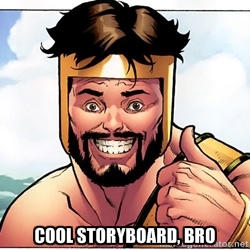This is the post for the November 7, 2014 class meeting.
 Today’s reading is about moving to the organization and planning stage for your projects. Your goal today is to organize the content portion of your project, using whatever works best for you.
Today’s reading is about moving to the organization and planning stage for your projects. Your goal today is to organize the content portion of your project, using whatever works best for you.
Mock-up Tools
Mock-ups are usually used for websites, projects that are “static” (like posters or brochures), and texts that are primarily linguistic or visual in nature. Wireframes (if you’re familiar with the term) fall into this category. Be sure to use the Mock-up guidelines on p. 95 of Writer/Designer to guide your process.
You could use one of the tools that was reviewed in class: Froont or Codepen. You can also use a tool specifically designed for mock-ups like Mockflow, Invision (30-day free trial), Frame Box, or Pencil Project.
You could try a flowcharting tool (like Gliffy or Lucidchart) or mindmapping tool (like bubbl.us or Coggle).
Storyboarding Tools
Storyboarding is usually used for projects that move through a series of pieces, places, or points in time—like a video, comic book, or graphic novel. Be sure to use the storyboard guidelines on p. 97–98 of Writer/Designer to guide your process. For the storyboard for the Don Quixote remix, Pierce used a comic strip generator to make his storyboard.
Storyboarding is, essentially, outlining your text visually, so you may be happy with creating a simple outline in Google Docs. For online tools I’ve made, I created storyboards with PowerPoint, because it was simple and I had a copy. If you do go this route, Google Slides would work too.
If you want to try something specifically created for storyboarding, take at look at these resources for creating and organizing storyboards:
- StoryboardThat
- Amazon Storyteller
- Shotbox
- Toon Boom Storyboard (30 day trial)
- WeVideo (video creation with built-in storyboarding)
Old-Fashioned Tools
Good, old paper and pencil can work for mock-ups and storyboards. There’s no reason that these planning tools have to be digitally produced. Sketch them out if you want to, but then scan them or take a photo so that you can add them to your blog on Monday.
Writing Schedule and Homework
-
Friday, 11/7: Work on your mock-up and/or storyboard. Be sure to write and publish a blog post for today that talks about what you have accomplished since your last post and why you did what you did. Remember to keep up with the milestones you planned on your project timelines on Wednesday.
-
Monday, 11/10: We will talk about rough cuts and revision plans, covered in Chapter 7. Link, insert, or embed a mock-up and/or storyboard for your project in your blog post for the day.
-
Wednesday, 11/12: We will talk about publishing your project and your presentations, using information from Chapter 8.
-
Friday, 11/14: Lots of independent work.